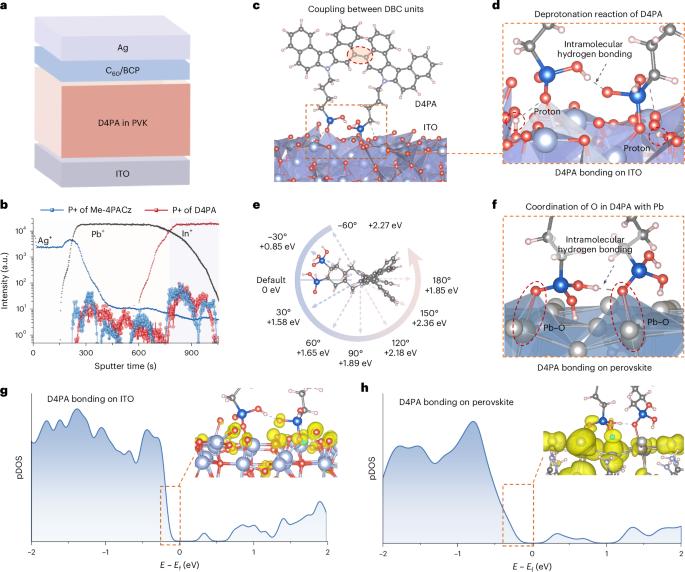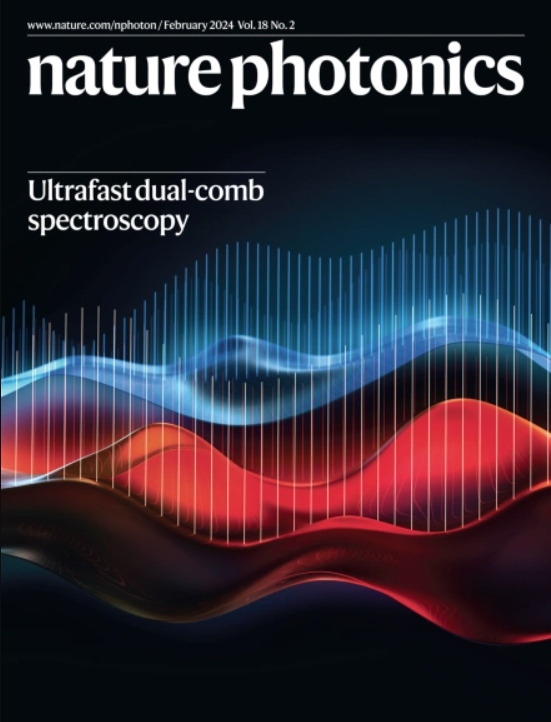高效钙钛矿太阳能电池通过抑制分子间聚集在孔选择接触
IF 32.9
1区 物理与天体物理
Q1 OPTICS
引用次数: 0
摘要
孔选择接触对于提高钙钛矿太阳能电池的性能至关重要,但其优化仍然面临障碍。例如,在溶液处理过程中,实现均匀沉积和防止小分子材料聚集是具有挑战性的,这会对电池的效率、可重复性和稳定性产生负面影响。在这里,我们与钙钛矿膜共沉积了一种新的p型小分子(D4PA)。D4PA中的分子内C-C耦合能够与钙钛矿和衬底进行强多锚定相互作用,增强界面电荷传输并抑制钙钛矿层内缺陷的形成。C-C耦合还引入了位阻,产生扭曲的分子构象,有效地防止了分子聚集,延长了溶液的可加工性,提高了设备的可重复性。我们的器件在小面积器件中具有26.72%的认证功率转换效率和26.14%的认证最大功率点跟踪效率。在有效面积为10.86 cm2的微型模块中,功率转换效率为23.37%,认证最大功率点跟踪效率为22.66%。在最大功率点连续运行2500小时后,这些设备保持了超过97.2%的初始效率。本文章由计算机程序翻译,如有差异,请以英文原文为准。


High-efficiency perovskite solar cells enabled by suppressing intermolecular aggregation in hole-selective contacts
Hole-selective contacts are crucial for improving the performance of perovskite solar cells, but their optimization still faces obstacles. For example, it is challenging to achieve uniform deposition and prevent aggregation of small-molecule materials during solution processing, negatively impacting cell efficiency, reproducibility and stability. Here we co-deposit a new p-type small molecule (D4PA) with the perovskite film. The intramolecular C–C coupling in D4PA enables strong multi-anchoring interactions with both the perovskite and substrate, enhancing interfacial charge transport and inhibiting defect formation within the perovskite layer. The C–C coupling also introduces steric hindrance, creating twisted molecular conformations that effectively prevent molecular aggregation, extend the solution processability and increase device reproducibility. Our devices exhibit a certified power conversion efficiency of 26.72% and a certified maximum power point tracking efficiency of 26.14% in small-area devices. A power conversion efficiency of 23.37% and a certified maximum power point tracking efficiency of 22.66% are achieved in a mini-module with an effective area of 10.86 cm2. The devices maintain over 97.2% of their initial efficiency after 2,500 h of continuous operation at their maximum power point. A new p-type small molecule enhances defect passivation and improves interfacial charge transport in perovskite solar cells, enabling devices with a certified power conversion efficiency of 26.72%, 97% of which is maintained after 2,500 h of continuous operation.
求助全文
通过发布文献求助,成功后即可免费获取论文全文。
去求助
来源期刊

Nature Photonics
物理-光学
CiteScore
54.20
自引率
1.70%
发文量
158
审稿时长
12 months
期刊介绍:
Nature Photonics is a monthly journal dedicated to the scientific study and application of light, known as Photonics. It publishes top-quality, peer-reviewed research across all areas of light generation, manipulation, and detection.
The journal encompasses research into the fundamental properties of light and its interactions with matter, as well as the latest developments in optoelectronic devices and emerging photonics applications. Topics covered include lasers, LEDs, imaging, detectors, optoelectronic devices, quantum optics, biophotonics, optical data storage, spectroscopy, fiber optics, solar energy, displays, terahertz technology, nonlinear optics, plasmonics, nanophotonics, and X-rays.
In addition to research papers and review articles summarizing scientific findings in optoelectronics, Nature Photonics also features News and Views pieces and research highlights. It uniquely includes articles on the business aspects of the industry, such as technology commercialization and market analysis, offering a comprehensive perspective on the field.
 求助内容:
求助内容: 应助结果提醒方式:
应助结果提醒方式:


